The 6 Business Skills Every Artist Needs
Are your business chops lacking? Jake Parker, Anthony Wheeler, and Lee White teach how to market your work, communicate with clients, unravel contracts, and more to create a sustainable career. Tune in to take your business from good to great.
Got a Question for the Podcast? Ask it
hereNote: We’ve done our best to provide relevant links to products mentioned in this podcast. Qualifying purchases support SVSLearn and the 3 Point Perspective podcast. Thank you for your patronage!
KEY TAKEAWAYS
- Being reliable and easy to work with is just as much, if not more, of a selling point to clients as a stellar portfolio.
- Communication matters. It’s better to inform a client of an issue than to stay silent and hope they don’t ask questions.
- You don’t need to be the best at social media, but choose at least one platform on which to create a posting rhythm that supports your goals.
- You have negotiation power. Don’t be afraid to ask clients for what you want (but keep it respectful, not demanding).
- Don’t let your desire to please a client prevent you from asking for ample time to do the job.
SUMMARY
While we’d love to say art skills alone will guarantee a great illustration career, the reality is a bit more complicated. It’s essential to market your work, navigate negotiations, and deliver on commitments professionally.
If you didn’t learn how to operate an illustration business in art school, never fear; here are the six most valuable skills you can develop to create a thriving professional life.
- Packaging Your Work
Present your best self to the world. Keep your social media posts consistent (either in style or genre) and don’t crowd your grid with off-brand images.
- Inbound and Outbound Marketing
Find ways to reach potential customers and clients, including via social media and an email list.
- Pricing Your Work
If you’re just getting started, set an hourly rate. (Talking with other illustrators can help you settle on a fair number.) As a new professional, determining how long a project will take (and therefore, what to charge for it) can be challenging. An hourly rate is a good place to start while you find your flow.
If you’re an advanced illustrator, a day rate or flat rate for a project is a better option. You’ll be able to determine those rates after taking several similar jobs and experiencing what they require from you.
- Learn about Contracts and Negotiation
If you don’t speak legalese, find someone who does (an attorney is a good idea) to help you decipher contracts before you sign them. ChatGPT, while no replacement for a human pro, can also provide insights on a contract’s terms and help you understand them.
During the negotiation process, don’t be afraid to ask for terms that serve not only your client, but yourself. You’ll be surprised at how many want to accommodate you.
- Client Communication
Communicate clearly with and respond in a timely manner to your clients. Be quick to ask clarifying questions, assess expectations, and inform them when you hit bumps in the road. A great question to ask a client is, “What are you prioritizing in this project?” This will help you know whether they most value exceptional art, quick turnaround times, or something else.
Remember that the client-illustrator relationship involves two-way communication. Don’t expect them to dictate every move to you, and remember that your input is equally important.
- Project Management and Scope Control
Learn how much time you need to complete different projects. (Yes, actually track your time and record the results.) This will help you identify the time investment for new projects before you accept them, allowing you to determine your availability, reasonable deadlines, and how much to charge.
Action Items:
- Define the pricing for the services you offer, including your day rate.
- Educate yourself on the key components of a standard contract.
- Build a communication checklist: Form a list of questions to ask any client before taking a new job, such as the pay rate, how they want files delivered, and their desired turnaround times. Give yourself a timeline for checking in with your client throughout the illustration process.
- Clean up your portfolio to include only work that appeals to your ideal client. Show consistency of style and genre.
If you like this episode, please share it, subscribe, and let us know your thoughts or if you learned something new!







